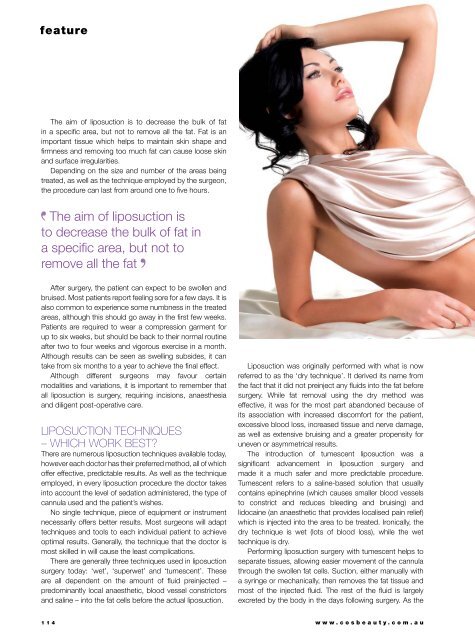Cosmetic Surgery and Beauty Magazine #64
Cosmetic Surgery & Beauty Magazine is the definitive guide to the aesthetic medicine industry for anyone considering a treatment therapy or surgical procedure. This quality quarterly publication contains comprehensive information about practitioners, equipment, techniques, processes and options, presented clearly and completely. The strong emphasis on input by industry professionals provides profiles of the practitioners and understanding of their approach to each procedure, enabling readers to make informed choices in their initial approaches to deciding what will best suit their needs. Hundreds of untouched before-and-after photographs provided by the practitioners themselves graphically illustrate both treatable conditions and the results that can be obtained. Cosmetic Surgery & Beauty Magazine is essential reading for anyone wishing to inform themselves about the options available in aesthetic medicine in Australia.
Cosmetic Surgery & Beauty Magazine is the definitive guide to the aesthetic medicine industry for anyone considering a treatment therapy or surgical procedure. This quality quarterly publication contains comprehensive information about practitioners, equipment, techniques, processes and options, presented clearly and completely. The strong emphasis on input by industry professionals provides profiles of the practitioners and understanding of their approach to each procedure, enabling readers to make informed choices in their initial approaches to deciding what will best suit their needs. Hundreds of untouched before-and-after photographs provided by the practitioners themselves graphically illustrate both treatable conditions and the results that can be obtained. Cosmetic Surgery & Beauty Magazine is essential reading for anyone wishing to inform themselves about the options available in aesthetic medicine in Australia.
Create successful ePaper yourself
Turn your PDF publications into a flip-book with our unique Google optimized e-Paper software.
feature<br />
The aim of liposuction is to decrease the bulk of fat<br />
in a specific area, but not to remove all the fat. Fat is an<br />
important tissue which helps to maintain skin shape <strong>and</strong><br />
firmness <strong>and</strong> removing too much fat can cause loose skin<br />
<strong>and</strong> surface irregularities.<br />
Depending on the size <strong>and</strong> number of the areas being<br />
treated, as well as the technique employed by the surgeon,<br />
the procedure can last from around one to five hours.<br />
The aim of liposuction is<br />
to decrease the bulk of fat in<br />
a specific area, but not to<br />
remove all the fat<br />
After surgery, the patient can expect to be swollen <strong>and</strong><br />
bruised. Most patients report feeling sore for a few days. It is<br />
also common to experience some numbness in the treated<br />
areas, although this should go away in the first few weeks.<br />
Patients are required to wear a compression garment for<br />
up to six weeks, but should be back to their normal routine<br />
after two to four weeks <strong>and</strong> vigorous exercise in a month.<br />
Although results can be seen as swelling subsides, it can<br />
take from six months to a year to achieve the final effect.<br />
Although different surgeons may favour certain<br />
modalities <strong>and</strong> variations, it is important to remember that<br />
all liposuction is surgery, requiring incisions, anaesthesia<br />
<strong>and</strong> diligent post-operative care.<br />
Liposuction techniques<br />
– which work best?<br />
There are numerous liposuction techniques available today,<br />
however each doctor has their preferred method, all of which<br />
offer effective, predictable results. As well as the technique<br />
employed, in every liposuction procedure the doctor takes<br />
into account the level of sedation administered, the type of<br />
cannula used <strong>and</strong> the patient’s wishes.<br />
No single technique, piece of equipment or instrument<br />
necessarily offers better results. Most surgeons will adapt<br />
techniques <strong>and</strong> tools to each individual patient to achieve<br />
optimal results. Generally, the technique that the doctor is<br />
most skilled in will cause the least complications.<br />
There are generally three techniques used in liposuction<br />
surgery today: ‘wet’, ‘superwet’ <strong>and</strong> ‘tumescent’. These<br />
are all dependent on the amount of fluid preinjected –<br />
predominantly local anaesthetic, blood vessel constrictors<br />
<strong>and</strong> saline – into the fat cells before the actual liposuction.<br />
Liposuction was originally performed with what is now<br />
referred to as the ‘dry technique’. It derived its name from<br />
the fact that it did not preinject any fluids into the fat before<br />
surgery. While fat removal using the dry method was<br />
effective, it was for the most part ab<strong>and</strong>oned because of<br />
its association with increased discomfort for the patient,<br />
excessive blood loss, increased tissue <strong>and</strong> nerve damage,<br />
as well as extensive bruising <strong>and</strong> a greater propensity for<br />
uneven or asymmetrical results.<br />
The introduction of tumescent liposuction was a<br />
significant advancement in liposuction surgery <strong>and</strong><br />
made it a much safer <strong>and</strong> more predictable procedure.<br />
Tumescent refers to a saline-based solution that usually<br />
contains epinephrine (which causes smaller blood vessels<br />
to constrict <strong>and</strong> reduces bleeding <strong>and</strong> bruising) <strong>and</strong><br />
lidocaine (an anaesthetic that provides localised pain relief)<br />
which is injected into the area to be treated. Ironically, the<br />
dry technique is wet (lots of blood loss), while the wet<br />
technique is dry.<br />
Performing liposuction surgery with tumescent helps to<br />
separate tissues, allowing easier movement of the cannula<br />
through the swollen fat cells. Suction, either manually with<br />
a syringe or mechanically, then removes the fat tissue <strong>and</strong><br />
most of the injected fluid. The rest of the fluid is largely<br />
excreted by the body in the days following surgery. As the<br />
114 www.cosbeauty.com.au


















